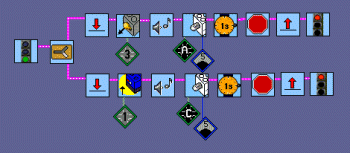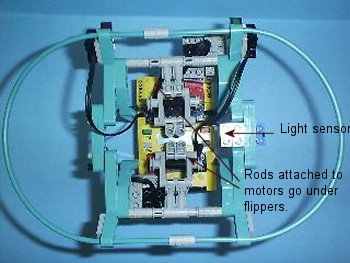
Kent
NGfL Robolab Project
2000 - 2001
The gadget is a form of scorer for a ball game, switching lights on or off when the ball landed in its net. Stage one simply turns on two lights, one red, one green, both on port A, for six seconds. There are no sensors involved at all, so therefore no reaction to a ball landing in the "net".
At stage two, a light sensor is attached, and the lights are now attached to ports A and C. This is the program for stage two of the model.


When we ran the program, the lights came on straight away, before the ball landed in the net. When the ball landed in the net, the lights stayed on. According to the program, the lights should have been off until the light level dropped as the ball passed the sensor. We then tried changing the light levels from <55 to <44 and from <55 to 42. We ran the modified program successfully - the lights came on when the ball dropped into the net and went out when the ball was removed. However, the light sensors are very sensitive and we found that depending on the time of day, the position of the model in the room and people bending over to observe the model, all had an effect on the program, so that the light levels were different each time and sometimes needed resetting.
 The
children had worked with an adult helper on the final two
stages, but the model and the programming were too difficult
for all concerned and had everyone completely baffled! I
had to backtrack to the end of stage one with the group
to check that the model had been correctly built and to
talk through with them what they thought was meant to happen.
This model is fine for a group to work on with a helper
or unaided, but teacher supervision is needed for the final
two stages, unless the helper has had a fair bit of Robolab
experience.
The
children had worked with an adult helper on the final two
stages, but the model and the programming were too difficult
for all concerned and had everyone completely baffled! I
had to backtrack to the end of stage one with the group
to check that the model had been correctly built and to
talk through with them what they thought was meant to happen.
This model is fine for a group to work on with a helper
or unaided, but teacher supervision is needed for the final
two stages, unless the helper has had a fair bit of Robolab
experience.
At stage three, the position of the light sensor is reversed, so that it points away from the net. A touch sensor replaces the light sensor to detect a ball landing in the central part of the model (turning on the green light attached to port A). The final step of altering the model at stage three was not clear, with these instructions being actually part of stage four. Once we had figured out what to do, we "read" the program to predict what the model's reaction would be. We thought that the light sensor could be to detect a "near miss", turning on the red light attached to port C. However, we need to do more work with this model to see if we are right!

 At
stage four, we couldn't predict what was supposed to happen!
We didn't try to build the model to this stage, as there
didn't seem to be much point. The timer fork was completely
new to us and without the optional Robolab Activity Pack
(274 black and white pages covering classroom management,
how to use the worksheets, whole class activities etc at
a cost of £19.15), we couldn't work out what was supposed
to happen, why or how! We hadn't found the Amusement Park
Activity Pack particularly helpful, so we hadn't wasted
our money on this one. If anyone knows what this program
means, please let us know!
At
stage four, we couldn't predict what was supposed to happen!
We didn't try to build the model to this stage, as there
didn't seem to be much point. The timer fork was completely
new to us and without the optional Robolab Activity Pack
(274 black and white pages covering classroom management,
how to use the worksheets, whole class activities etc at
a cost of £19.15), we couldn't work out what was supposed
to happen, why or how! We hadn't found the Amusement Park
Activity Pack particularly helpful, so we hadn't wasted
our money on this one. If anyone knows what this program
means, please let us know!

Instead of pursuing stages three and four, we decided that we would try and adapt the model so that it would throw the ball back to the shooter once a goal had been scored. This involved some rebuilding and original programming from the children themselves, but they were absolutely determined to succeed. Their program for their adapted model will be included here in the next day or so.

If you are a regular visitor to my site and find the free resources useful, please consider making a donation. All proceeds go towards hosting fees and keeping this not-for-profit website ad free.
 Copyright © 2002 to 2011 Diane Hawkins All rights Reserved.
Copyright © 2002 to 2011 Diane Hawkins All rights Reserved.
Subscription services are not allowed to link to this site.
Graphics from Printmaster Gold UK Publishing Suite version 7 "The images used herein were obtained from Mindscape's PrintMaster product, (c) 1998 Mindscape, Inc., 88 Rowland Way, Novato, CA 94945 USA. All rights reserved."
~ Site Design by Diane Hawkins ~